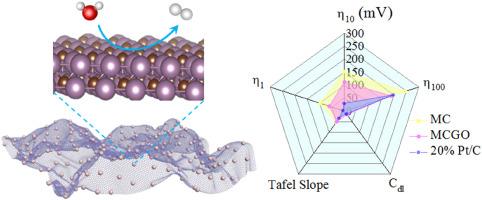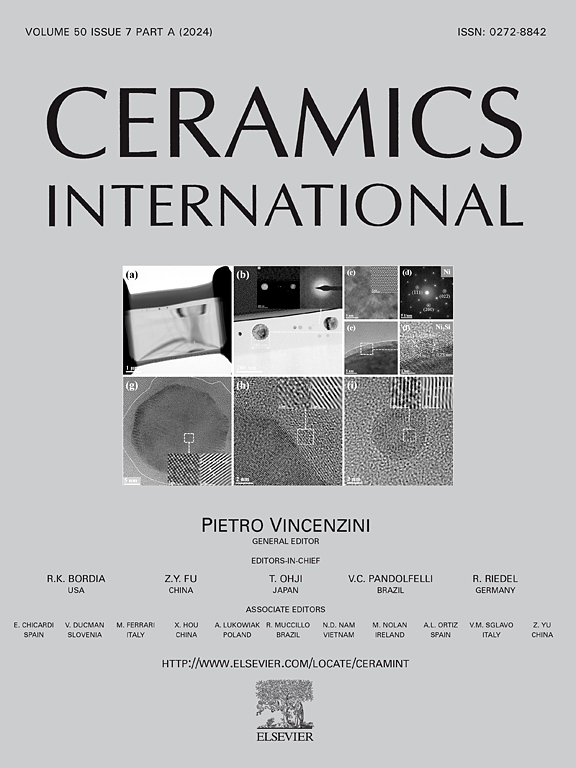原位剥离石墨烯以锚定和调节 Mo2C NPs 的晶面,用于制氢
IF 5.6
2区 材料科学
Q1 MATERIALS SCIENCE, CERAMICS
引用次数: 0
摘要
大规模制氢需要一种经济高效的无贵金属催化剂。在这里,通过原位支撑氧化石墨烯(GO)层、在 GO 层之间锚定钼酸盐离子以及热解,Mo2C 纳米颗粒(NPs)被很好地分散在二维石墨烯纳米片表面。上述策略还对暴露的晶面进行了调整。结果表明,二维 rGO 纳米片上锚定了均匀且分散良好的 Mo2C NPs,其尺寸分布较窄,并暴露出双晶面。氢气进化反应(HER)的结果表明,最佳的 Mo2C/rGO 催化剂在碱性溶液中只需较低的过电位(η10,112 mV)就能驱动 10 mA cm-2 的反应,而且经过 1000 次循环测试后,η10 只增加了 12 mV,这表明该催化剂具有较高的氢气进化活性和稳定性。值得注意的是,当电流密度超过 100 mA cm-1 时,过电位低于 Pt/C 商用催化剂。优异的性能得益于 Mo2C 催化剂上较低的氢吸附吉布斯自由能(ΔGH*)。因此,所提出的策略能有效地制备出分散良好且双晶面外露的 Mo2C NPs,用于电催化氢气进化。本文章由计算机程序翻译,如有差异,请以英文原文为准。


In-situ exfoliating graphene to anchor Mo2C NPs and modulate crystal planes for hydrogen production
An economical and efficient noble metal-free catalyst is necessary for large-scale hydrogen production. Here, Mo2C nanoparticles (NPs) were well-dispersed on the surface of 2D graphene nanosheets by in-situ propping oxide graphene (GO) layers, anchoring molybdate ions between GO layers and pyrolysis. The exposed crystal planes were also adjusted by above strategy. The results indicate that uniform and well-dispersed Mo2C NPs with a narrow size distribution were anchored on 2D rGO nanosheets and exposed dual crystal planes. The results of hydrogen evolution reaction (HER) show that the optimal Mo2C/rGO catalyst only needs low overpotential (η10, 112 mV) to drive 10 mA cm−2 in alkaline solution, and η10 only increased by 12 mV after 1000 cycles test, indicating high activity and stability for HER. Notably, the overpotential is below than that of Pt/C commercial catalyst when current density is more than 100 mA cm−1. The excellent performance is benefit from low hydrogen adsorption Gibbs free energy (ΔGH∗) on the Mo2C catalyst. Therefore, the proposed strategy is efficient to prepare well-dispersed and dual crystal planes-exposed Mo2C NPs for electrocatalytic hydrogen evolution.
求助全文
通过发布文献求助,成功后即可免费获取论文全文。
去求助
来源期刊

Ceramics International
工程技术-材料科学:硅酸盐
CiteScore
9.40
自引率
15.40%
发文量
4558
审稿时长
25 days
期刊介绍:
Ceramics International covers the science of advanced ceramic materials. The journal encourages contributions that demonstrate how an understanding of the basic chemical and physical phenomena may direct materials design and stimulate ideas for new or improved processing techniques, in order to obtain materials with desired structural features and properties.
Ceramics International covers oxide and non-oxide ceramics, functional glasses, glass ceramics, amorphous inorganic non-metallic materials (and their combinations with metal and organic materials), in the form of particulates, dense or porous bodies, thin/thick films and laminated, graded and composite structures. Process related topics such as ceramic-ceramic joints or joining ceramics with dissimilar materials, as well as surface finishing and conditioning are also covered. Besides traditional processing techniques, manufacturing routes of interest include innovative procedures benefiting from externally applied stresses, electromagnetic fields and energetic beams, as well as top-down and self-assembly nanotechnology approaches. In addition, the journal welcomes submissions on bio-inspired and bio-enabled materials designs, experimentally validated multi scale modelling and simulation for materials design, and the use of the most advanced chemical and physical characterization techniques of structure, properties and behaviour.
Technologically relevant low-dimensional systems are a particular focus of Ceramics International. These include 0, 1 and 2-D nanomaterials (also covering CNTs, graphene and related materials, and diamond-like carbons), their nanocomposites, as well as nano-hybrids and hierarchical multifunctional nanostructures that might integrate molecular, biological and electronic components.
 求助内容:
求助内容: 应助结果提醒方式:
应助结果提醒方式:


